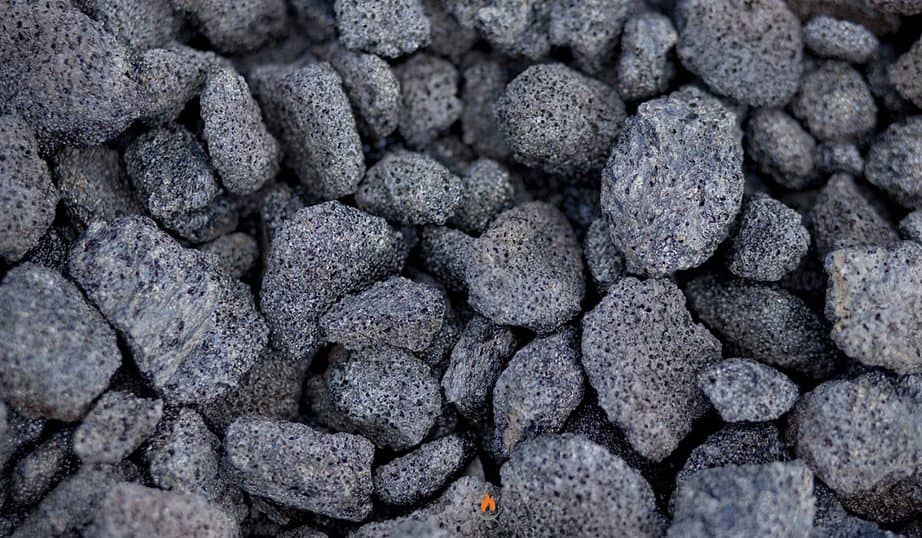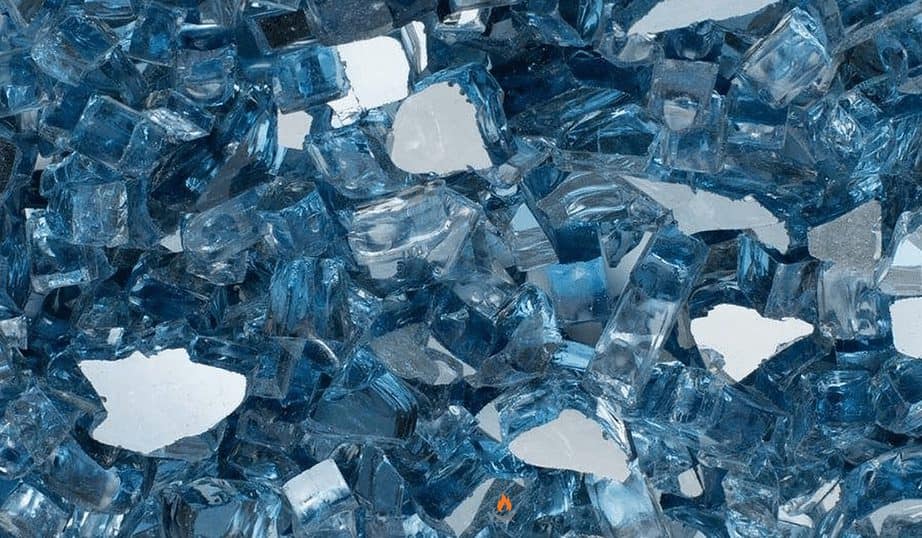Have you got new propane or natural gas fire pit, or are you shopping for one and trying to decide whether to go with lava rock or fire glass? What if you could mix lava rock and fire glass? Your decision on which fire pit media to go with might be easier than you think.
So, can you mix lava rock and fire glass?
When used together in a propane or natural gas fire pit, lava rock and fire glass can complement each other.
Mixing lava rock and fire glass, or layering them on top of each other in a fire pit’s burner pan, are practical alternatives to using one or the other alone.
Regardless of which option you choose, there are several functional, cosmetic, and financial benefits to using the two media together in your gas fire pit.
Fire pit lava rock and glass compliment each other well – together providing better heat distribution, more protection for key fire pit components, a greater number of design options, and substantial cost savings when buying fire pit media.
Let’s keep going and talk about the benefits of using fire pit rock and glass together and how you can do it in your propane fire pit.

What is Gas Fire Pit Media?
Gas fire pit media is the natural lava rock, artificial clear or colored glass beads, a.k.a. fire glass, or firerock (artificial rock), that sits in the burner pan, keeping heat evenly distributed.
There is another primary benefit to using fire pit media that I’ll cover in greater detail below. Let’s say it has to do with making your gas fire pit last longer and having an overall lower cost of ownership.
For this article, we’ll cover fire pit lava rock and fire glass specifically and leave firerock for another article shortly.

Fire Pit Lava Rock
Chances are, the fire pit lava rock you’ll find at your local home and garden or fire pit specialty store is the basaltic rock formed when volcanic lava flows harden.
Most of the world’s lava rock falls in this category. Ask your local or online supplier if they know if the lava rock they sell is basaltic. They should be able to give you an answer.
Basaltic lava rock is naturally good at retaining heat but performs well as an insulator – two traits not often found in nature. These traits make lava rock ideal for fire pits used for several reasons.
For example, lava rock is commonly used today as a heat storer in experimental thermal energy storage/power generation technologies, with examples here and here.
As an insulator, lava rock is used as a primary component of rock wool insulation – an option growing in popularity due to its high performance and lower cost compared to fiberglass insulation.
Also, lava rock (basalt) is naturally fire-resistant – a feature you’d want in building materials.
Fun Fact: Basalt is the rock of choice of hot-stone massage therapists due to its heat retention properties.
For gas fire pit use, the combination of low cost relative to performance is why lava rock is a good option.
Check out my article Why Use Lava Rock for a Fire Pit for more on the benefits of using lava rock in your propane fire pit.

Fire Pit Fire Glass
Fire glass used in fire pits is typically decorative tempered glass with smooth polished surfaces, used, like lava rock, to distribute heat throughout the fire pit’s burner pan evenly.
| What is tempered glass? According to Webster’s Dictionary, tempered glass has been “treated to impart increased strength and the property of shattering into pellets when broken.” |
Fire pit fire glass is generally available in various colors, shapes, and textures, and this variety is often the primary draw to fire glass for consumers.
You can get lava rock in different sizes (anywhere from 1/4 in. to 6 in.) and colors (typically red or black/gray), but the number of size/shape/texture combinations available is much more significant for fire glass.
Fire pit glass performs the same as lava rock from a heat distribution standpoint. Still, it is significantly more expensive when bought in similar quantities by weight or volume (typically by the lb. or sqft) – costing anywhere from 3 to 4 times more per pound.
Benefits of Using Lava Rock with Fire Glass
As I mentioned at the beginning of the article, there is a combination of functional, cosmetic, and cost-related reasons for using lava rock and fire glass together.
Fire pit media provides a physical “buffer zone” between the actual flame and the heating element.
The gas from the heating element travels between the cracks and crevices of whatever media you are using, fueling the flame on the surface.
This buffer zone, provided by the fire pit media, protects the heating element and metal fire pit pan from damage due to long-term direct high-heat exposure.
Fire glass can perform this job well, but lava rock’s superior natural insulating qualities rule among the two.
One other thing from a functionality standpoint – fire glass tends to have more intense radiant heat, whereas lava rock is more subtle in its heat output.
When you mix lava rock and fire glass, the characteristics of each can work well together and be adjusted to the kind of performance you are looking for heat-wise.
Cosmetically, fire glass looks great, and you have many options, as I mentioned before. Lava rock doesn’t look bad, but it’s not as visually appealing as fire glass.
One downside for fire glass in this category is that it will show dirt and soot more clearly, requiring cleaning from time to time.
When well-maintained, I think it’s safe to say fire glass brings an advantage to the table.
Financially, fire pit lava rock will cost significantly less than the equivalent amount of fire glass. Due to its other strengths, it may also save you money on maintenance/replacement costs in the long run.
Your overall savings depend on how much lava rock you buy to complement your fire glass.
With lava rock and fire glass, you get the best heat protection option for your fire pit’s key components, better looks/more design options, and a lower overall fire pit media cost.
Layering Lava Rock and Fire Glass
The most common way lava rock and fire glass are combined is through layering the two.
When using this method, you will use the lava rock as the base layer, surrounding the heater element and providing a foundation for the eventual placement of your fire glass.
Use enough lava rock to fill the burner pan to a level that provides a thin layer high enough to cover the heating element.
Once this is done, apply a thick fire glass layer to hide the lava rock from view.
Do the best you can here – naturally, using darker glass can help make the lava rock less visible.
For planning purposes, about 20-25% of your fire pit media will be fire glass and the rest lava rock.
Mix Lava Rock and Fire Glass
When you mix lava rock and fire glass, you still get the advantages of lava rock’s insulating properties and a lower cost, just not relatively as low as you’ll likely use more fire glass.
How much of each type of fire pit media is up to you, but a 1:1 ratio is typical. Some vendors even sell them pre-mixed.
Conclusion: Can You Mix Lava Rock and Fire Glass in a Fire Pit?
You can mix lava rock and fire glass in a fire pit. The two work very well together in various ways to protect your investment and enhance your fire pit experience at a lower cost.
Try to shop with knowledgeable vendors, either in-person or online, who can assist you with advice and guidance when determining the way to go with your fire pit media needs.
Also, don’t overpay for lava rock or glass – with the number of fire pit media options out there today, it can be easy to do that. Shop around!
Also, consult your owner’s manual and installer before mixing lava rock and fire glass to ensure you are using enough fire pit media correctly for your particular gas fire pit model.
Take care, and thanks for reading!
John
Related Questions
How much does a pound of fire glass cost? A pound of lava rock?
After surveying the prices of three online vendors (American Fire Glass, Star Fire Direct, and Fire Pits Direct), the average price/lb. for 1/2 in. fire glass was $5.15, and $2.60 for 1/2 in. lava rock. The price of shipping was not included in the price calculations as all three vendors offer free shipping.
How do you clean a gas fire pit’s fire glass?
There’s no way to do this job well without removing all of the fire glass from your fire pit and washing it by hand in batches. So, to do so:
- I recommended using work/gardening gloves when removing fire glass from your fire pit; there may be broken pieces that could injure you during the removal/washing process
- Pro Tip #1: While the fire glass is removed from your gas fire pit’s burner pan, remove all debris (leaves, dirt, broken fire glass pieces, etc.) and wipe down the burner pan surface in preparation for the soon-to-be clean fire glass – you don’t want to put clean fire glass back into a dirty burner pan
- If your gas fire pit is equipped with drains, ensure they are unobstructed and functioning correctly.
- Take a large colander or other sieve-like container and fill it halfway up with dirty fire glass – you may have to do this several times, depending on how much you have to wash.
- Rinse once to get the bulk of the loose dirt and soot washed off, and then once with dish soap, Simple Green, etc., gently stirring the glass with a solid kitchen spoon, or gloved hand, to ensure good water/soap coverage
- Do a final rinse to remove all soap from the fire glass, continuing to stir; be thorough here to avoid the haze from dried soap when the fire glass is back in your fire pit.
- To dry, pick a location outside that won’t be disturbed by children or pets, and spread the wet fire glass evenly – preferably in a spot with a good breeze and direct sunlight.
- When dried, collect the fire glass in a bucket, bowl, etc., and gently place it back into your fire pit burner pan.
- Pro Tip #2: Choose a darker shade of fire glass if you don’t see yourself regularly cleaning it – the darker color will hide discoloration from dirt, soot, etc.
How long does fire pit glass last?
Tempered fire pit glass will last almost indefinitely from a functional standpoint. It may lose some of its luster and chip over time from weather, heat, dirt, handling, etc., but it will still do its job to protect the fire pit and evenly distribute heat.
As long as you use the fire glass as directed and handle it with care when filling your burner pan or cleaning it, you’ll have it for a long time.
You’ll most likely want a new color or texture before your fire glass even thinks about wearing out.
If you eventually decide to mix lava rock and fire glass in your fire pit, this combination can lengthen the useful life of your fire glass by many years as well.

